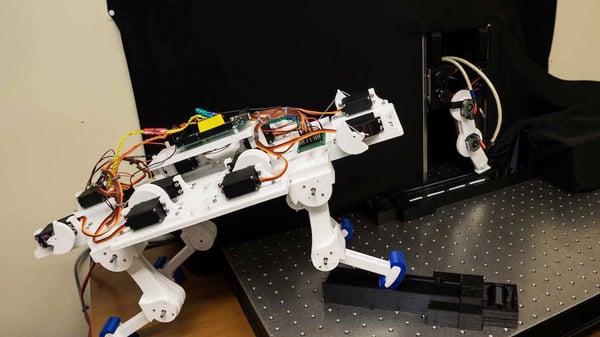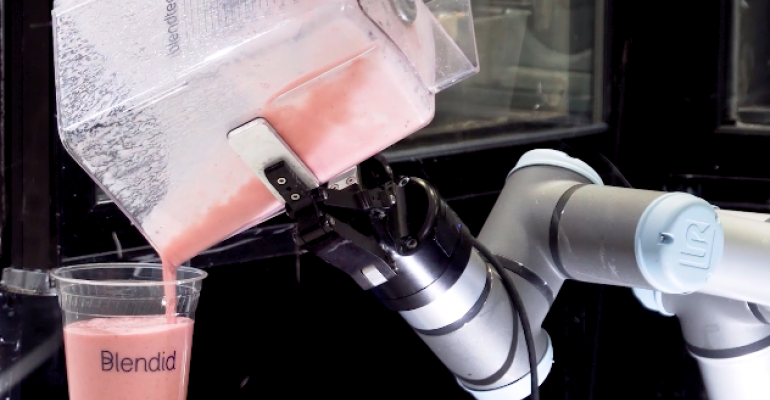What's New In Robotics? 15.03.2019

Posted on Mar 15, 2019 7:02 AM. 9 min read time
Hi! In this week's news mix: Barcelona launches a 5G robotics pilot, Circuit Bread meets UR, and could cobots be a way around proposed "robot taxes"? Elsewhere, we discover USC's potentially ground-breaking algorithm, zap swordfish with Colin Angle, admire a soft gripper that can lift 100 times its weight and much more!
Cobots & manufacturing
CCIONA, Orange and 5G Barcelona have launched a “Collaborative and autonomous robots” pilot to explore the impact of low latency 5G technology on robot-to-robot communication in manufacturing environments.
Reeco Automation has received the Henry Ford Award for successfully integrating a collaborative robot into Ford's manufacturing process. "Both larger and smaller manufacturers are increasingly seeing the benefits of integrating cobots into their production processes, not to replace the human workforce but to complement them," Reeco's Managing Director, Llewelyn Rees told Robotics Tomorrow.
Circuit Bread met up with Tim DeGrasse from Universal Robots to find out more about the company's collaborative robots. The result? Circuit Bread staff are now "actively trying to figure out how we can justify getting one of these in the office"...
An astonishing 79 per cent of automation distributors do not believe their customers understand the safety requirements of installing a collaborative robot, according to the results of the Global Robotics Report. [If you're new to cobot safety topics, make sure to check out Robotiq's eBook "Collaborative Robots Risk Assessment, An Introduction."]
Doosan released video showing its cobot helping out with a tire change....
Collaborative robots may provide a way for companies "to avoid the wrathful eye of the regulators, as they look to impose punitive measures on businesses which replace humans with automation," Bernard Marr suggested in Forbes this week. "Politicians have already proposed “robot taxes” to cover these eventualities – fostering harmonious working relationships between humans and machines could be a trend which will set people’s minds at ease in 2019."
In part 4 of its “Doing with duAro” miniseries, Kawasaki introduces the duAro2, the latest addition to its line of dual-arm cobots...
Festo has revealed the BionicSoftHand --a pneumatically operated, bio-inspired gripper that builds on existing Festo technology and could one day find its way into collaborative work spaces.
The BionicSoftArm is a new development of Festo's BionicMotionRobot, whose range of applications has been significantly expanded. Its modular design can be combined with up to seven pneumatic bellows segments and rotary drives. This guarantees maximum flexibility in terms of reach and mobility, enabling it to work around obstacles even in the tightest of spaces. At the same time, it is completely flexible and can work safely with people.
In related news:
- Working and Growing With Collaborative Robots (Quality Digest)
- 60 Seconds with… Jeff Burnstein, President of A3 (MMH)
- SAE targets 700th aircraft scheduled maintenance this year (The Sun Daily)
- The story behind Kawasaki’s duAro 2 robot (Robotics & Automation News)
- TrakRap: Embracing industry 4.0 in manufacturing (Manufacturing Global)
Elsewhere...
In what could prove to be a major breakthrough for robotics development, DARPA has announced the development of an AI-controlled robotic limb that can learn over time in much the same way animals and humans do.

Credit: University of Southern California/Mathew Lin
All part of a wider project targeting the development of true lifelong machine learning, the new, bio-inspired algorithm at the heart of the system is able to learn a new walking task by itself after only 5 minutes of unstructured play (also known as "motor babbling"). The algorithm enables robot limbs to adapt to other tasks without any additional programming. (More: PC Mag has an interview with Dr. Francisco Valero-Cuevas, co-author of a paper on the research. Paper: Autonomous functional movements in a tendon-driven limb via limited experience)
iRobot CEO Colin Angle, co-founder of Robots in Service of the Environment (RSE) has announced the launch of the Guardian LF1 Mark 3, the latest prototype version of his swordfish zapping and gathering robot.

Credit: Robots in Service of the Environment
Vis RSE:
"The Lionfish are destroying the coral reef and decimating fish populations in the Atlantic. The latest innovations incorporated into the RSE Guardian LF1, enable the undersea robotic solution to go deeper, fish longer and pull in a larger haul. With each technical milestone we cross we get one step closer to saving our greatest natural resource by empowering fisherman with new tools,” said Colin Angle.
Roboticists at the Institute for Human & Machine Cognition (IHMC) in Florida, U.S.A. are working on a new humanoid robot dubbed 'Nadia' (after gymnast Nadia Comăneci, the first gymnast to be awarded a perfect score of 10.0 at the Olympic Games).

Credit: IHMC
It's part of a three year project that launched in January 2019, but this week IEEE Spectrum's Evan Ackerman published a fascinating interview with Robert Griffin, a research scientist at IHMC that gets into the nuts and bolts of the project:
"We’re targeting the height and weight of a human, as well as being in the ballpark of human volume. So design targets are between 5'7" and 6'0", and sub-90 kg. [...] We’re really hesitant to say when you’ll be seeing a Nadia walking around, because we want to design the robot properly and not rush things. But I can say that one of the final ONR project goals is to show Nadia performing tasks autonomously."
Finally, a new study has found that when robots beat humans in contests for cash prizes, people tend to regard themselves as being "less competent and expend slightly less effort—and tend to dislike the robots," Futurity reported.

What surprised me most about this research is not the human reactions it describes, but the fact that an easy fix for this issue appears to have been missed: simply pay robots in a currency they can understand --reliable power supplies, quality care and maintenance, well-written code and excellent after sales service-- and they won't have any further interest in hustling humans for cash prizes. Easy peasy! ;)
And in other news:
- Our Robotics Innovation Centre has been officially launched (CSIRO)
- 3 New Chips to Help Robots Find Their Way Around (IEEE Spectrum)
- Meet Tengai, the job interview robot who won't judge you (BBC)
- You Might Be a Robot. This Is Not a Joke. (Bloomberg)
- Researchers explore interactions between preschoolers and robotic partners (TechXplore)
Come by next week for more of the latest robotics news! Until then, please enjoy..
Five vids for Friday
1. Researchers at MIT’s Computer Science and Artificial Intelligence Laboratory (CSAIL) have created an origami-inspired, vacuum-driven, 3D-printed soft gripper that can lift 100 times its own weight. (Paper: A Vacuum-driven Origami “Magic-ball” Soft Gripper)
2. University of Washington researchers have unveiled a robot that can feed people who find it a challenge to feed themselves. (Paper: Towards Robotic Feeding: Role of Haptics in Fork-Based Food Manipulation)
3. MetaFly is the latest bio-inspired bot from Edwin Van Ruymbeke. Instead of relying on motors, like traditional designs, MetaFly relies solely on its wings, which eliminates the need for bulky batteries.
4. Cambridge Consultants unveiled Mamut this week. Mamut is an autonomous, mobile robot packed with sensors that "explores crop fields, capturing data on health and yield at the level of individual plants and on a massive scale."
5. Science Robotics released a cool video that asks "Where's my robotic construction crew?" (More: A review of collective robotic construction)






Leave a comment